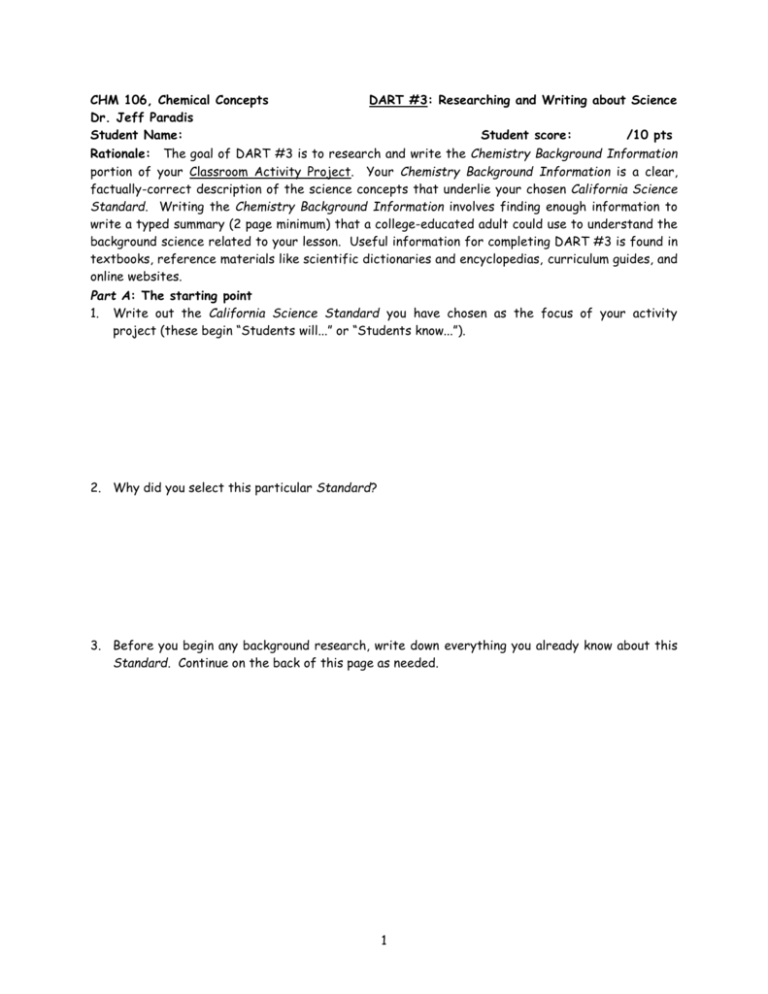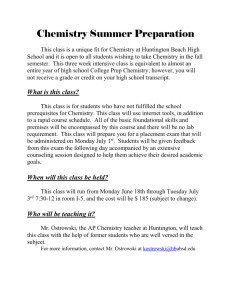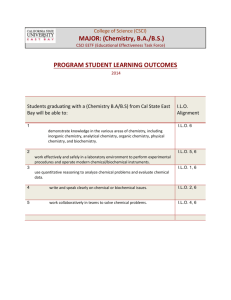DART 3 : Writing a Summary of Chemistry Background Information
advertisement

CHM 106, Chemical Concepts Dr. Jeff Paradis Student Name: DART #3: Researching and Writing about Science Student score: /10 pts Rationale: The goal of DART #3 is to research and write the Chemistry Background Information portion of your Classroom Activity Project. Your Chemistry Background Information is a clear, factually-correct description of the science concepts that underlie your chosen California Science Standard. Writing the Chemistry Background Information involves finding enough information to write a typed summary (2 page minimum) that a college-educated adult could use to understand the background science related to your lesson. Useful information for completing DART #3 is found in textbooks, reference materials like scientific dictionaries and encyclopedias, curriculum guides, and online websites. Part A: The starting point 1. Write out the California Science Standard you have chosen as the focus of your activity project (these begin “Students will...” or “Students know...”). 2. Why did you select this particular Standard? 3. Before you begin any background research, write down everything you already know about this Standard. Continue on the back of this page as needed. 1 Part B: The Science Framework for California Schools Read the information related to your specific Standard in one of the copies of the Science Framework for California Schools that has been provided for you in the classroom. 4. On what page of the Science Framework did you find your Standard? 5. Use the space below to take notes on what you read in the Science Framework, also make a list of the key terms that can be used to search for more information. Continue on the back of this page as needed. Part C: In-class research of your topic Now you are ready to locate, read, and summarize relevant information found in your textbook and the additional textbooks and science encyclopedias that are in the classroom. The terms you’ve identified in question 5 are good starting search terms to use for locating more information. Be sure to summarize the information from at least 3 different sources before going on to Part D (in the end you’ll need at least 4 references for your final Classroom Activity Project report). 6. For each of these sources, list the citation (so you’ll be able to reference it in your final report for your Classroom Activity Project) and take notes, in your own words, concerning the key points related to your Standard. There is room on the next page for citations #2 and #3. Continue on the back of this page or on separate pages as needed. Citation for source #1: Notes from source #1: 2 Question 6 continued…again, use the back of this page or attach additional pages as needed. Citation for source #2: Notes from source #2: Citation for source #3: Notes from source #3: 3 Part D: Making a concept map Concept maps are an excellent way to organize new information. They allow us to see the relationships between terms as well as to see if we are missing any key information. Below is a sample concept map that was developed the first week of class. Here the main concept is “matter”. The terms “mass”, “volume”, “chemistry”, “properties”, and “sub-microscopic particles” are all supporting concepts related to our main concept. Though there are none in this example, it is possible for supporting concepts to have further, additional supporting concepts. One-directional arrows and connecting phrases are used to explain the relationship between concepts. Examples can be used to clarify concepts. examples: water air people pen rock NOT examples: light sound thoughts love has Matter ma characterized by Chemistry is the study of Mass has de of Volume Sub-microscopic particles examples (DEMO): Properties H2 is flammable He is non-flammable 7. What word or phrase is the main concept behind your selected science standard? 8. Looking back at the information you have summarized in questions 5 and 6, what words or phrases are supporting concepts related to the main concept? 9. On the back of this page or on a separate sheet of paper, begin organizing the words you came up with in questions 7 and 8 into a concept map. Here are a few things to remember when making a concept map: There is not just one right way to organize your concept map. The layout can be changed as you develop the map. To make this easier, you may want to first do a trial layout on a whiteboard or by using sticky notes that can be moved around. Start by placing the main concept in a circle in the middle of the page. Next place supporting concepts in their own circles somewhere near the main concept. Each concept appears only once on the map. Connect related concepts using an arrow that has a word or phrase that describes the relationship between the connected concepts. 4 Once you have completed Part D, show your work to your instructor. Your instructor will record your 10 pts for completing the in-class portion of DART #3. Part E and Part F are designed to be completed on your own and are designed to help you finish writing your Chemistry Background Information section of your Classroom Activity Project. Part E: Additional out-of-class searching Your final Classroom Activity Project report requires that you have at least 4 background resources (only one of which can be a web page). If you don’t have 4 resources yet, or if you don’t have enough information yet to write a minimum of 2 pages, you will need to find some additional reference. The library is a great place to start. There you can find chemistry textbooks, science dictionaries and encyclopedias (reference department), and curriculum guides. The library also maintains on-line research guides that can be helpful (you can find links on our CHM 106 class webpage). 10. On a separate piece of paper, summarize, in your own words, the information about your topic based on your reading of each of these additional sources. Again, record the citation information for each additional source. Part F: Writing the Chemistry Background Information of your Classroom Activity Project There are several techniques to help you get beyond the “blank page syndrome”. Here are several suggestions for getting started: Try “focused free writing”, where you just start writing continuously whatever comes to mind about your topic. It doesn’t have to be structured or coherent (no one else will ever see it). Later you can take what emerges and write the organized summary. Another way is to talk it out with someone else. Someone who knows nothing about the topic may ask the questions that are about the main points of your summary. Your verbal explanation may show you what you know and don’t yet know. A third way is to write an outline in the form of a “Table of Contents”. Here you list the concepts you identified in your research, with the main concept as the “Title”. This is for your own use and you can rearrange these in a logical order after you get them down. Any of these techniques (or others that work for you) can be used to produce a sequential list of points you want to cover and act as a guide for your writing. What ever method you use, remember to keep referring back to the summaries you wrote in questions 5, 6 and 10 as well as the concept map you drew in question 9 to make sure that you have hit all the main points and that you have correctly described the relationship between key concepts. 11. Your completed, typed Chemistry Background Information (2 page minimum) will be submitted in a few weeks as part of your Rough Draft (see page 2 of the Classroom Activity Project Directions for more information on the Rough Draft). You will get feedback on your Rough Draft that you can then use to revise your Chemistry Background Information before submitting it as part of your final Classroom Activity Project report at the end of the semester. I hope DART #3 gives you some new tools to help you with your writing… Best of luck! 5






